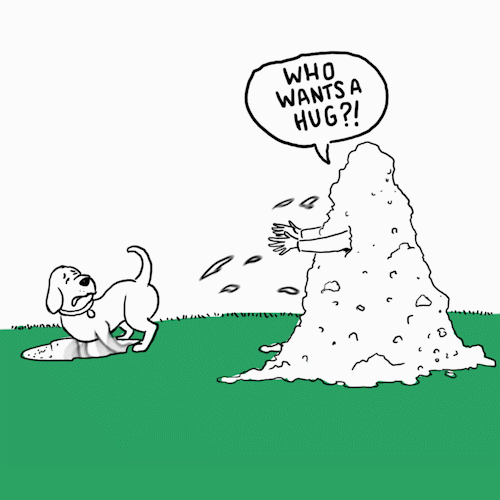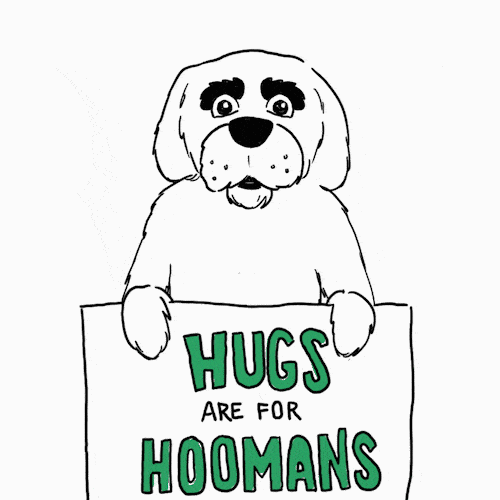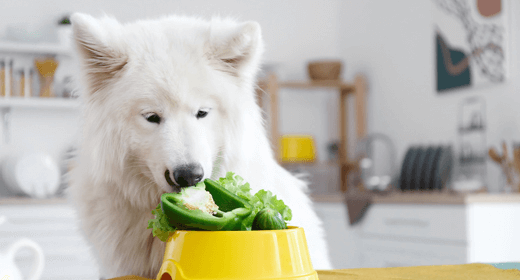

Most humans recognise a hug as a sign of affection and close friendship. That is exactly why we feel this strong urge to hug dogs out of love. After all, they are the best type of best friends. As pet parents, we love greeting our pawsome pals with dog hugs. However, do dogs like hugs? In an IAMS™ survey*, 83% of dog parents say their dog likes hugs too. Is this true? We’re going to try and get an answer to this question.

The short answer is no. Dogs do not like hugs. Now, let’s look at a bit of an explanation to this.
Some dogs enjoy canine cuddles, but usually only with their owner or household members. Otherwise, they don’t care about it. “Hugging is too much and overwhelming for many dogs and should be discouraged if the dog doesn’t know the individual very well”, advises James Serpell, B.Sc., Ph.D., Professor of Humane Ethics & Animal Welfare at the University of Pennsylvania School of Veterinary Medicine.
So, why don’t dogs like hugs? To understand this, we may need to look at what a dog really feels when you try to hug it.
Here is what your pooch probably experiences when you try to engulf it in an embrace:
Hugging is human behaviour and not dog behaviour. These animals are just not physically built for that kind of interaction. We stand upright, so we face people. Dogs are on all fours, making hugging an unnatural act for them. Hence, they prefer a friendly sniff.
To dogs, a hug comes off as dominating behaviour; it feels like someone is trying to assert control over them. It can be stressful, especially if done by a stranger.

Since ancient times, a canine’s first instinctive defense has been to run away from danger. And hugging makes them feel trapped and confined. As humans, we too feel awkward when a person we barely know gives us a long and tight hug, right? Dogs somewhat feel the same. To some extent, they would also want to escape.
Sniffing is a dog’s way of expressing love. However, we humans definitely don’t regard sniffing the same way. And no matter how much we love our canine companion, we do feel a little uncomfortable with this gesture. Similarly, your pet might find hugs discomforting. Don’t worry. A dog’s body language will give you all the signs you need to know about their comfort level. But in order to understand these signs, you must learn to read them. So, let us understand some signs that indicate your dog is uneasy.
Dogs try to avoid anything that stresses them out. So, if your dog looks away when you enfold them in your arms, they don't like hugs. Your furry friend might also open their eyes wide while looking away and this allows you to notice their whale eyes. Whale eyes are when you see the whites of a dog’s eyes. Now, that is another indication of stress and discomfort.
Dogs are generally flexible when relaxed. If your dog gets stiff when you wrap your hands around them, you should probably set them free. Your dog might also lower or tuck their tail under the belly out of stress. Moreover, you must also pay attention to your pet’s ears. Lowered ears are a sign of a stressed dog.
It’s no news that we yawn when exhausted. However, if your pooch yawns during dog hugs, they are getting stressed out. It is their way of conveying that they don’t like something.
Every dog is unique. While most of them feel uncomfortable with hugs, some might like being embraced. Here’s how you can confirm if your furball doesn’t feel suffocated when you hug them:
Tail wagging can mean several things. However, you know your dog is happy when they give you a full-body tail wag. Slow, relaxed wags mean that your dog feels composed and at ease.
Placing the paws on the hugger signifies that your dog welcomes this form of attention. A dog’s paws can do more than just walk and dig holes. It is one of the most effective modes of communication for them.
Don’t worry if your dog doesn’t want to hug it out. There are plenty of healthier ways you can show them you are still their best friend:
If you're looking for the perfect dog for you, try our Dog Breed Selector today and enjoy a lifetime of tail-wagging joy.
Dogs do not generally recognise a hug as an affectionate gesture. However, they learn to accept hugs from their owner.
Your dog might not look at hugs the way humans do. For most dogs, hugs are discomforting.
Yes. Dogs like cuddling because they love you. If your dog cuddles you, you are a part of their pack.


When visiting the store, dog owners can get overwhelmed by the array of dog food options available, from dry kibble to canned wet food and more. These processed foods may not be appealing to humans, but they contain all the nutrients that dogs need to stay healthy. Like humans, dogs also need a variety of nutrients from their food, not just from meat as their main diet, but also from grains, vegetables, and fruits. This kind of balance is usually weighed by pet food labels in kibbles or wet food in grams for different types of dogs.
For optimum health, dogs need food that is tailored and customized to their life stages, starting from when they are puppies and all the way into adulthood. Puppies have completely different nutrient needs compared to adult dogs as they are still in their early stages of life. They need enough nutrients to fuel a speedy growth, especially after transitioning away from their mother's milk. Puppies require complete and balanced nutrition with protein to help build their tissues, fats or healthy skin, hair, brain, and vision, carbohydrates for energy, vitamins, minerals, and water.
The need for balanced nutrients in puppies starts with the mother during pregnancy, followed by lactation and growth. Sufficient nourishment for the mother is pivotal in enhancing the puppies’ growth inside the womb and preparing them for life after birth. Both mother and puppy should receive well-proportioned antioxidants, DHA, and prebiotics to support their health and growth as provided by the IAMS product line, which contains DHA that is essential for puppies' brain development while also supporting the mother's pregnancy and quality of milk produced.
While puppies need the primary nutrients for growth, adult dog food has a different level of complexity. Adult dog food requires the same make-up of nutrients as puppies do but tailored to their specific needs. Recent research indicates that an adult dog requires at least 10% of its daily calories from protein and at least 5.5% from fat. Adult dogs need quality protein for firm muscles and a healthy immune system. Additionally, an adult diet can contain up to 50% carbohydrates, with fiber ranging from 2.5 to 4.5%. There is no specific prescribed amount of fibre for adult dog consumption daily, however, it is still one of the most important components in dog food to address constipation and support a healthy weight.
Adult dogs in their prime also require a balance in antioxidants to reduce systemic inflammation and restore active muscles. They should receive Vitamin E and C to support their immune system, joint health, and prevent inflammation. As they grow older, they may be exposed to different diseases from diabetes to cancers, which can be prevented by polyphenols. Parents to adult dogs must acknowledge the most suitable food for their loved one that is comprised of the right amount of nutrients and can look to the IAMS line as they are formulated to support healthy bones and joint health, scientifically proven for healthy digestion with a good fibre and prebiotic blend, as well as antioxidants for a strong immune system.
Besides life stage, balanced nutrition should be adjusted to their breed, which give insight to different factors like weight, mouth size, and energy level. This will then determine the type of kibble and food given. Smaller breeds tend to be more active, requiring the same essential nutrients and prebiotics for a healthy body as well as smaller-sized kibble designed specifically for their smaller mouths. As smaller dogs relatively have a high metabolism, higher levels of protein, fat, and essential fatty acids like omega 3 and omega 6 are some of the important nutrients that should be available in their food. On the other hand, larger breeds require foods that are lower in fat and calories, contain slightly lower levels of calcium and phosphorus, and have a specific balance of calcium-to-phosphorus ratio to support stronger bones and muscles. Owners can look to products like the small breed line from IAMS, containing 7 essential nutrients to build strong muscles, support their tiny immune system while protecting their healthy skin and coat, and the product line for adults for large breeds.
Dog parents must acknowledge and understand the unique needs, life stage and characteristics in their dog to choose the right dog food so their furry ones can grow into their healthiest selves. Make sure to visit your vet regularly to check these components as well!